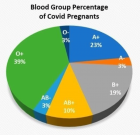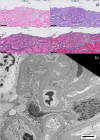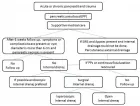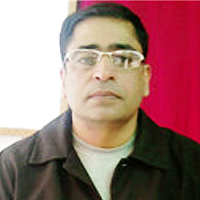Abstract
Research Article
Immune system and quality of life following aerobic exercise versus resistance exercise training among Alzheimer’s
Fadwah M Al-Sharif*
Published: 30 April, 2020 | Volume 4 - Issue 1 | Pages: 003-008
Background: Globally, Alzheimer’s disease (AD) affects millions of elderly individuals are affected with AD who suffer from decline in cognitive ability. However, immune system dysfunction has a role in AD pathogenesis. However, pharmacological therapeutic intervention for caring of ADis not available. Therefore there is a need to develop novel therapeutic modalities for AD individual care.
Objective: The objective of the this trial was to detect immune system and quality of life (QOL) response following aerobic versus resisted exercise training among AD subjects.
Methods: Fifty older with AD disease the range of age ranged was 61 to 73 years enrolled in the current study. However, smoking, liver, chest, renal, metabolic and cardiac dysfunction considered as exclusion criteria. Participants were randomly enrolled into group (A) who applied aerobic exercise intervention, while group (B) applied resisted exercise intervention for period of six months.
Results: The SF-36 which measure QOL along with in the immunological parameters (CD3 count, CD4 count, CD8 count and CD4/CD8 ratio) showed significant improvement following aerobic and resisted exercise. However, comparing between both groups showed significant differences with greater significant improvement in all measured parameters following aerobic exercise training (p < 0.05).
Conclusion: Aerobic exercise is the most appropriate exercise to improve immune system and quality of life among elderly Alzheimer’s.
Read Full Article HTML DOI: 10.29328/journal.aaai.1001018 Cite this Article Read Full Article PDF
Keywords:
Aerobic exercise; Aging; Alzheimer’s; Resisted exercises; Immune system; Quality of life
References
- Jensen CS, Bahl JM, Østergaard LB, Høgh P, Wermuth L, et al. Exercise as a potential modulator of inflammation in patients with Alzheimer's disease measured in cerebrospinal fluid and plasma. Exp Gerontol. 2019; 121: 91-98. PubMed: https://www.ncbi.nlm.nih.gov/pubmed/30980923
- Dos Santos Picanco LC, Ozela PF, de Fatima de Brito Brito M, Pinheiro AA, Padilha EC, et al. Alzheimer’s disease: a review from the pathophysiology to diagnosis, new perspectives for pharmacological treatment. Curr Med Chem. 2018; 25: 3141–3159. PubMed: https://www.ncbi.nlm.nih.gov/pubmed/30191777
- World Health Organization. Global health and aging. 2019.
- Rubio-Perez JM, Morillas-Ruiz JM. A review: inflammatory process in Alzheimer’s disease, role of cytokines. Scientific World Journal. 2012; 2012: 756357. PubMed: https://www.ncbi.nlm.nih.gov/pubmed/22566778
- Melrose RJ, Ettenhofer ML, Harwood D, Achamallah N, Campa O, et al. Cerebral metabolism, cognition and functional abilities in Alzheimer disease. J Geriatr Psychiatry Neurol. 2011; 24: 127–134. PubMed: https://www.ncbi.nlm.nih.gov/pubmed/21856969
- Heneka MT, Carson MJ, El Khoury J, Landreth GE, Brosseron F, et al. Neuro inflammation in Alzheimer’s disease. Lancet Neurol. 2015; 14: 388-405. PubMed: https://www.ncbi.nlm.nih.gov/pubmed/25792098
- Heppner FL, Ransohoff RM, Becher B. Immune attack: The role of inflammation in Alzheimer disease. Nat Rev Neurosci.2015; 16: 358-372. PubMed: https://www.ncbi.nlm.nih.gov/pubmed/25991443
- Van Eldik LJ, Carrillo MC, Cole PE, Feuerbach D, Greenberg BD, et al. The roles of inflammation and immune mechanisms in Alzheimer’s disease. Alzheimers Dement (N Y). 2016;2: 99-109. PubMed: https://www.ncbi.nlm.nih.gov/pubmed/29067297
- Mossaheb N, Zehetmayer S, Jungwirth S, Weissgram S, Rainer M, et al. Are specific symptoms of depression predictive of Alzheimer's dementia? J Clin Psychiatry. 2012; 73: 1009–1015. PubMed: https://www.ncbi.nlm.nih.gov/pubmed/22687442
- Lyketsos CG, Carrillo MC, Ryan JM, Khachaturian AS, Trzepacz P, et al. Neuropsychiatric symptoms in Alzheimer's disease. Alzheimers Dement. 2011; 7: 532–539. PubMed: https://www.ncbi.nlm.nih.gov/pubmed/21889116
- Heun R, Schoepf D, Potluri R, Natalwala A. Alzheimer's disease and co-morbidity: increased prevalence and possible risk factors of excess mortality in a naturalistic 7-year follow-up. Eur Psychiatry. 2013; 28: 40–48. PubMed: https://www.ncbi.nlm.nih.gov/pubmed/21924588
- Alzheimer’s Impact Movement. Alzheimer’s Disease Caregivers Factsheet. Chicago, IL. Alzheimer’s Association; 2017.
- Idorn M., Hojman P. Exercise-dependent regulation of NK cells in cancer protection. Trends Mol Med. 2016; 22: 565–577. PubMed: https://www.ncbi.nlm.nih.gov/pubmed/27262760
- Hayashino Y, Jackson JL, Hirata T, Fukumori N, Nakamura F, et al. Effects of exercise on C-reactive protein, inflammatory cytokine and adipokine in patients with type 2 diabetes: a meta-analysis of randomized controlled trials. Metabol Clin Exp. 2014; 63: 431–440.
- Neefkes-Zonneveld CR, Bakkum AJ, Bishop NC, Tulder MW, Janssen TW. Effect of long-term physical activity and acute exercise on markers of systemic inflammation in persons with chronic spinal cord injury: a systematic review. Arch Phys Med Rehabil. 2015; 96: 30–42. PubMed: https://www.ncbi.nlm.nih.gov/pubmed/25064781
- Hammonds TL, Gathright EC, Goldstein CM, Penn MS, Hughes JW. Effects of exercise on c-reactive protein in healthy patients and in patients with heart disease: a meta-analysis. Heart Lung. 2016; 45: 273–282. PubMed: https://www.ncbi.nlm.nih.gov/pubmed/26916454
- Meneses-Echavez JF, Correa-Bautista JE, González-Jiménez E, Schmidt RJ, Elkins M, et al. The effect of exercise training on mediators of inflammation in breast cancer survivors: a systematic review with meta-analysis. Cancer Epidemiol Biomarkers Prev. 2016; 25: 1009–1017. PubMed: https://www.ncbi.nlm.nih.gov/pubmed/27197276
- Radak Z, Hart N, Sarga L, Koltai E, Atalay M, et al. Exercise plays a preventive role against Alzheimer's disease. J Alzheimers Dis. 2010; 20: 777–783. PubMed: https://www.ncbi.nlm.nih.gov/pubmed/20182027
- Hawley JA, Hargreaves M, Joyner MJ, Zierath JR. Integrative biology of exercise. Cell. 2014; 159: 738–749. PubMed: https://www.ncbi.nlm.nih.gov/pubmed/25417152
- De la Rosa A, Olaso-Gonzalez G, Arc-Chagnaud C, Millan F, Salvador-Pascual A, et al. Physical exercise in the prevention and treatment of Alzheimer’s disease. J Sport Health Sci. 2020; 1-11.
- Ware J, Kosinski M, Gandek B. SF-36 health survey: manual & interpretation guide. Lincon, RI: Quality Metric Incorporated. 2000.
- Robergs RA, Landwehr R. The surprising history of the ‘‘HRmax=220-age’’ equation. J Exer Physiol. 2002; 5: 1–10.
- Ramalho AC, de Lourdes Lima M, Nunes F, Cambuí Z, Barbosa C, et al. The effect of resistance versus aerobic training on metabolic control in patients with type-1 diabetes mellitus. Diabetes Res Clin Pract. 2006; 72: 271–276. PubMed: https://www.ncbi.nlm.nih.gov/pubmed/16406128
- Vasefi M, Hudson M, Ghaboolian-Zare E. Diet Associated with Inflammation and Alzheimer’s Disease. J Alzheimers Dis Rep. 2019; 3: 299-309. PubMed: https://www.ncbi.nlm.nih.gov/pubmed/31867568
- Anshu Agrawal, Janet Baulch, Munjal Acharya, Sudhanshu Agrawal. Identification of Peripheral Immune Mechanisms playing a protective role in Alzheimer's Disease progression. J Immunol. 2019; 202: 36.
- Frederiksen KS, Gjerum L, Waldemar G, Hasselbalch SG. Effects of physical exercise on Alzheimer's disease biomarkers: a systematic review of intervention studies. J Alzheimers Dis. 2018; 61: 359–372. PubMed: https://www.ncbi.nlm.nih.gov/pubmed/29154278
- Kelly A. Exercise-Induced Modulation of Neuroinflammation in Models of Alzheimer’s Disease. Brain Plast. 2018; 4: 81–94. PubMed: https://www.ncbi.nlm.nih.gov/pubmed/30564548
- Drela N, Kozdron E, Szczypiorski P. Moderate exercise may attenuate some aspects of immunosenescence. BMC Geriatr. 2004; 4: 8–15. PubMed: https://www.ncbi.nlm.nih.gov/pubmed/15456521
- Nieman DC, Cook VD, Henson DA, Suttles J, Rejeski WJ, et al. Moderate exercise training and natural killer cell cytotoxic activity in breast cancer patients. Int J Sports Med. 1995; 16: 334–337. PubMed: https://www.ncbi.nlm.nih.gov/pubmed/7558532
- Shinkai S, Kohno H, Kimura K, Komura T, Asai H, et al. Physical activity and immune senescence in men. Med Sci Sports Exerc. 1995; 27: 1516–1526. PubMed: https://www.ncbi.nlm.nih.gov/pubmed/8587488
- Crist DM, Mackinnon LT, Thomson RF, Atterbom HA, Egan PA. Physical exercise increases natural cellular-mediated tumor cytotoxicity in the elderly women. Gerontology. 1989; 35: 66–71. PubMed: https://www.ncbi.nlm.nih.gov/pubmed/2792786
- Peeri M, Azarbayjani M, Akbarpour M, Ebrahimi M. The effect of aerobic training on the immune system of aging men. Annals Biological Res. 2011; 2: 299-304.
- Kapasi ZF, Ouslander JG, Schnelle JF, Kutner M, Fahey JL. Effects of an exercise intervention on immunologic parameters in frail elderly nursing home residents. J Gerontol Med Sci. 2003; 58: 636–643. PubMed: https://www.ncbi.nlm.nih.gov/pubmed/12865480
- Bermon S, Philip P, Candito M, Ferrari P, Dolisic C. Effects of strength exercise and training on the natural killer cell counts in elderly humans. J Sports Med Phys Fitness. 2001; 41: 196–202. PubMed: https://www.ncbi.nlm.nih.gov/pubmed/11447362
- Flynn MG, Fahlman M, Brauun WA, Lambert CP, Bouillon LE, et al. Effects of resistance training on selected indexes of immune function in elderly women. J Appl Physiol. 1999; 86: 1905–1913. PubMed: https://www.ncbi.nlm.nih.gov/pubmed/10368355
- Flynn MG, Mcfarlin BK, Philips MD, Stewart LK, Timmerman KL. Toll-like receptor 4 and CD14 mRNA expression are lower in resistive exercise-trained elderly women. J Appl Physiol. 2003; 95: 1833–1842. PubMed: https://www.ncbi.nlm.nih.gov/pubmed/12832426
- Rall LC, Roubenoff R, Cannon JG, Abad LW, Dinarello CA, et al. Effects of progressive resistance training on immune response in aging and chronic inflammation. Med Sci Sports Exerc. 1996; 28: 1356–1365. PubMed: https://www.ncbi.nlm.nih.gov/pubmed/8933485
- Mcfarlin BK, Flynn MG, Campbell WW, Stewart LK, Timmerman KL. TLR4 is lower in resistance-trained older women and related to inflammatory cytokines. Med Sci Sports Exerc. 2004; 36: 1876–1883. PubMed: https://www.ncbi.nlm.nih.gov/pubmed/15514501
- Raso V, Benard G, DA Silva Duarte AJ, Natale VM. Effect of Resistance Training on Immunological Parameters of Healthy Elderly Women. Med Sci Sports Exerc. 2007; 39: 2152-2159. PubMed: https://www.ncbi.nlm.nih.gov/pubmed/18046186
- Miles MP, KraemerW J, NindlB C, Grove DS, Leach SK, et al. Strength, workload, anaerobic intensity and the immune response to resistance exercise in women. Acta Physiol Scand. 2003; 178: 155–1563. PubMed: https://www.ncbi.nlm.nih.gov/pubmed/12780390
- Bruunsgaard H, Pedersen BK. Special feature for the olympics: effects of exercise on the immune system in the elderly population. Immunol Cell Biol. 2000; 78: 523–531. PubMed: https://www.ncbi.nlm.nih.gov/pubmed/11050535
- Woods JA, Lowder TW, Keylock KT. Can exercise training improve immune function in the aged? Ann N Y Acad Sci. 2002; 959: 117–127. PubMed: https://www.ncbi.nlm.nih.gov/pubmed/11976191
- Rall LC, Roubenoff R, Cannon JG, Abad LW, Dinarello CA, et al. Effects of progressive resistance training on immune response in aging and chronic inflammation. Med Sci Sport Exerc. 1996; 28: 1356–1365. PubMed: https://www.ncbi.nlm.nih.gov/pubmed/8933485
- Brown DW, Balluz LS, Heath GW. Associations between recommended levels of physical activity and health-related quality of life—Findings from the 2001 Behavioral Risk Factor Surveillance System (BRFSS) Survey. Prev Med. 2003; 37: 520–528. PubMed: https://www.ncbi.nlm.nih.gov/pubmed/14572437
- Segal R, Evans W, Johnson D. Structured exercise improves physical functioning in women with stages I and II breast cancer: results of a randomized controlled trial. J Clin Oncol 2001; 19: 657–665. PubMed: https://www.ncbi.nlm.nih.gov/pubmed/11157015
- Painter P, Carlson L, Carey S, Paul SM, Myll J. Physical functioning and health-related quality-of-life changes with exercise training in hemodialysis patients. Am J Kidney Dis. 2000; 35: 482–492. PubMed: https://www.ncbi.nlm.nih.gov/pubmed/10692275
- Schmitz N, Kruse J, Kugler J. The association between physical exercises and health-related quality of life in subjects with mental disorders: results from a cross-sectional survey. Preventive Medicine 2004; 39: 1200–1207. PubMed: https://www.ncbi.nlm.nih.gov/pubmed/15539056
- Mahendra N. Exercise and behavioural management training improves physical health and reduces depression in people with Alzheimer’s disease. Evidence-based Healthcare. 2004; 8: 77–79.
- Bowen DJ, Fesinmeyer MD, Yasui Y, Tworoger S, Ulrich CM, et al. Randomized trial of exercise in sedentary middle aged women: effects on quality of life. Int J Behav Nutr Phys Act. 2006; 3: 34. PubMed: https://www.ncbi.nlm.nih.gov/pubmed/17020620
- Sørensen M, Anderssen S, Hjerman I, Holme I, Ursin H. The effect of exercise and diet on mental health and quality of life in middle-aged individuals with elevated risk factors for cardiovascular disease. J Sports Sci. 1999; 17: 369-377. PubMed: https://www.ncbi.nlm.nih.gov/pubmed/10413264
- Imayama I, Alfano CM, Cadmus Bertram LA, Wang C, Xiao L, et al. Effects of 12-month exercise on health-related quality of life: a randomized controlled trial. Prev Med. 2011; 52: 344-351. PubMed: https://www.ncbi.nlm.nih.gov/pubmed/21371498
- Abu-Omar K, Rütten A, Lehtinen V. Mental health and physical activity in the European Union. Soz Praventivmed. 2004; 49: 301-309. PubMed: https://www.ncbi.nlm.nih.gov/pubmed/15497649
- McAuley E, Mailey E, Mullen S, Szabo A, Wojcicki T, et al. Growth trajectories of exercise self-efficacy in older adults: influence of measures and initial status. Health Psychol. 2011; 30: 75–83. PubMed: https://www.ncbi.nlm.nih.gov/pubmed/21038962
- Hoffmann K, Frederiksen KS, Sobol NA, Beyer N, Vogel A, et al. Preserving cognition, quality of life, physical health and functional ability in Alzheimer's disease: the effect of physical exercise (ADEX trial): rationale and design. Neuroepidemiology. 2013; 41: 198-207. PubMed: https://www.ncbi.nlm.nih.gov/pubmed/24135720
- Paluska SA, Schwenk TL. Physical activity and mental health: current concepts. Sports Med. 2000; 29: 167– 180. PubMed: https://www.ncbi.nlm.nih.gov/pubmed/10739267
- Nichol K, Deeny SP, Seif J, Camaclang K, Cotman CW. Exercise improves cognition and hippocampal plasticity in APOE epsilon4 mice. Alzheimers Dement. 2009; 5: 287-294. PubMed: https://www.ncbi.nlm.nih.gov/pubmed/19560099
- van Praag H, Christie BR, Sejnowski TJ, Gage FH. Running enhances neurogenesis, learning, and long-term potentiation in mice. Proc Natl Acad Sci U S A. 1999; 96: 13427-13431. PubMed: https://www.ncbi.nlm.nih.gov/pmc/articles/PMC23964/
- Barde YA. Neurotrophins: a family of proteins supporting the survival of neurons. Prog Clin Biol Res. 1994; 390: 45-56. PubMed: https://www.ncbi.nlm.nih.gov/pubmed/7724649
- Stummer W, Weber K, Tranmer B, Baethmann A, Kempski O. Reduced mortality and brain damage after locomotor activity in gerbil forebrain ischemia. Stroke. 1994; 25: 1862-1869. PubMed: https://www.ncbi.nlm.nih.gov/pubmed/8073470
- Carro E, Trejo JL, Busiguina S, Torres-Aleman I. Circulating insulin-like growth factor I mediates the protective effects of physical exercise against brain insults of different etiology and anatomy. J Neurosci. 2001; 21: 5678-5684. PubMed: https://www.ncbi.nlm.nih.gov/pubmed/11466439
- Lu B, Chow A. Neurotrophins and hippocampal synaptic transmission and plasticity. J Neurosci Res. 1999; 58: 76-87. PubMed: https://www.ncbi.nlm.nih.gov/pubmed/10491573
- Black JE, Isaacs KR, Anderson BJ, Alcantara AA, Greenough WT. Learning causes synaptogenesis, whereas motor activity causes angiogenesis, in cerebellar cortex of adult rats. Proc Natl Acad Sci USA. 1990; 87: 5568-5572. PubMed: https://www.ncbi.nlm.nih.gov/pubmed/1695380
- Isaacs KR, Anderson BJ, Alcantara AA, Black JE, Greenough WT. Exercise and the brain: angiogenesis in the adult rat cerebellum after vigorous physical activity and motor skill learning. J Cereb Blood Flow Metab. 1992; 12: 110-119. PubMed: https://www.ncbi.nlm.nih.gov/pubmed/1370068
- Cotman CW, Berchtold NC. Exercise: a behavioral intervention to enhance brain health and plasticity. Trends Neurosci. 2002; 25: 295-301. PubMed: https://www.ncbi.nlm.nih.gov/pubmed/12086747
- Greist JH, Klein MH, Eischens RJ, Faris J, Gurman AS, et al. Running as treatment for depression. Compr Psychiatry. 1979; 20: 41 –54. PubMed: https://www.ncbi.nlm.nih.gov/pubmed/759100
Similar Articles
-
Atopic Conjunctivitis in Children: Influence of Treatment with Topical Cyclosporin 0.05% in the Quality of LifeCarlos Alberto Sánchez Salguero*,Álvaro Isidro Sánchez Chacón. Atopic Conjunctivitis in Children: Influence of Treatment with Topical Cyclosporin 0.05% in the Quality of Life . . 2017 doi: 10.29328/journal.haard.1001001; 1: 001-008
-
The use of Allergoids and Adjuvants in Allergen ImmunotherapyCelso Eduardo Olivier*. The use of Allergoids and Adjuvants in Allergen Immunotherapy. . 2017 doi: 10.29328/journal.haard.1001006; 1: 040-060
-
Chemo-cytokines network is main target for control of Allergic asthmaSeyyed Shamsadin Athari*,Seyyede Masoume Athari. Chemo-cytokines network is main target for control of Allergic asthma. . 2018 doi: 10.29328/journal.aaai.1001009; 2: 001-002
-
HIV-1 Immune evasion: The main obstacle toward a successful vaccineAmitis Ramezani*,Mona Sadat Larijani,Seyed Mehdi Sadat. HIV-1 Immune evasion: The main obstacle toward a successful vaccine . . 2018 doi: 10.29328/journal.aaai.1001013; 2: 013-015
-
Allergic Asthma and Sick building syndromeSeyyed Shamsadin Athari*. Allergic Asthma and Sick building syndrome . . 2019 doi: 10.29328/journal.aaai.1001015; 3: 001-002
-
Immune system and quality of life following aerobic exercise versus resistance exercise training among Alzheimer’sFadwah M Al-Sharif*. Immune system and quality of life following aerobic exercise versus resistance exercise training among Alzheimer’s. . 2020 doi: 10.29328/journal.aaai.1001018; 4: 003-008
-
Effectiveness of levocetirizine in treating allergic rhinitis while retaining work efficiencyDabholkar Yogesh, Shah Tanush, Rathod Roheet, Paspulate Akhila, Veligandla Krishna Chaitanya, Rathod Rahul, Devesh Kumar Joshi*, Kotak Bhavesh. Effectiveness of levocetirizine in treating allergic rhinitis while retaining work efficiency. . 2023 doi: 10.29328/journal.aaai.1001031; 7: 005-011
-
Efficacy and Safety of Sublingual Immunotherapy using a Combination of Dermatophagoides Pteronyssinus and Blomia Tropicalis Extracts in Patients with Allergic Rhinitis: A Randomized, Double-Blind, Placebo-Controlled TrialPriscilla Rios Cordeiro Macedo, Priscila Moraes, Luisa Karla Arruda, Fábio Fernandes Morato Castro, Jorge Kalil, Clóvis Eduardo Santos Galvão*. Efficacy and Safety of Sublingual Immunotherapy using a Combination of Dermatophagoides Pteronyssinus and Blomia Tropicalis Extracts in Patients with Allergic Rhinitis: A Randomized, Double-Blind, Placebo-Controlled Trial. . 2023 doi: 10.29328/journal.aaai.1001033; 7: 023-031
Recently Viewed
-
Immunological background for treatments with biologicals in CRSwNPL Klimek*,J Hagemann,I Casper,T Huppertz,A Bedbrook,J Bousquet. Immunological background for treatments with biologicals in CRSwNP. Arch Asthma Allergy Immunol. 2021: doi: 10.29328/journal.aaai.1001026; 5: 022-029
-
The Bacteriological Profile of Nosocomial Infections at the Army Central Hospital of BrazzavilleMedard Amona*,Yolande Voumbo Matoumona Mavoungou,Hama Nemet Ondzotto,Benjamin Kokolo,Armel Itoua,Gilius Axel Aloumba,Pascal Ibata. The Bacteriological Profile of Nosocomial Infections at the Army Central Hospital of Brazzaville. Int J Clin Microbiol Biochem Technol. 2025: doi: 10.29328/journal.ijcmbt.1001032; 8: 009-022
-
Nasal cytology in patients with previous SARS-CoV-2 infection: occurrence of atypical lymphocytesArturo Armone Caruso*, Anna Miglietta, Giovanni De Rossi, Liliana Nappi, Veronica Viola, Stefano De Rossi, Salvatore Del Prete, Clara Imperatore, Sabato Leo, Daniele Naviglio, Monica Gallo, Daniela Marasco, Lucia Grumetto. Nasal cytology in patients with previous SARS-CoV-2 infection: occurrence of atypical lymphocytes. Adv Treat ENT Disord. 2023: doi: 10.29328/journal.ated.1001014; 7: 001-006
-
Vestibular-limbic relationships: Brain mappingPaolo Gamba*. Vestibular-limbic relationships: Brain mapping. Insights Depress Anxiety. 2018: doi: 10.29328/journal.ida.1001006; 2: 007-013
-
May we feed cancer?Maria Grazia Spurio*. May we feed cancer?. Insights Depress Anxiety. 2018: doi: 10.29328/journal.ida.1001005; 2: 001-006
Most Viewed
-
Impact of Latex Sensitization on Asthma and Rhinitis Progression: A Study at Abidjan-Cocody University Hospital - Côte d’Ivoire (Progression of Asthma and Rhinitis related to Latex Sensitization)Dasse Sery Romuald*, KL Siransy, N Koffi, RO Yeboah, EK Nguessan, HA Adou, VP Goran-Kouacou, AU Assi, JY Seri, S Moussa, D Oura, CL Memel, H Koya, E Atoukoula. Impact of Latex Sensitization on Asthma and Rhinitis Progression: A Study at Abidjan-Cocody University Hospital - Côte d’Ivoire (Progression of Asthma and Rhinitis related to Latex Sensitization). Arch Asthma Allergy Immunol. 2024 doi: 10.29328/journal.aaai.1001035; 8: 007-012
-
Causal Link between Human Blood Metabolites and Asthma: An Investigation Using Mendelian RandomizationYong-Qing Zhu, Xiao-Yan Meng, Jing-Hua Yang*. Causal Link between Human Blood Metabolites and Asthma: An Investigation Using Mendelian Randomization. Arch Asthma Allergy Immunol. 2023 doi: 10.29328/journal.aaai.1001032; 7: 012-022
-
An algorithm to safely manage oral food challenge in an office-based setting for children with multiple food allergiesNathalie Cottel,Aïcha Dieme,Véronique Orcel,Yannick Chantran,Mélisande Bourgoin-Heck,Jocelyne Just. An algorithm to safely manage oral food challenge in an office-based setting for children with multiple food allergies. Arch Asthma Allergy Immunol. 2021 doi: 10.29328/journal.aaai.1001027; 5: 030-037
-
Snow white: an allergic girl?Oreste Vittore Brenna*. Snow white: an allergic girl?. Arch Asthma Allergy Immunol. 2022 doi: 10.29328/journal.aaai.1001029; 6: 001-002
-
Cytokine intoxication as a model of cell apoptosis and predict of schizophrenia - like affective disordersElena Viktorovna Drozdova*. Cytokine intoxication as a model of cell apoptosis and predict of schizophrenia - like affective disorders. Arch Asthma Allergy Immunol. 2021 doi: 10.29328/journal.aaai.1001028; 5: 038-040

If you are already a member of our network and need to keep track of any developments regarding a question you have already submitted, click "take me to my Query."




















































































































































